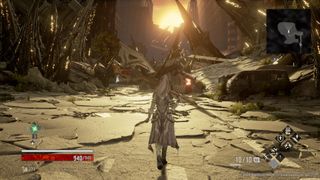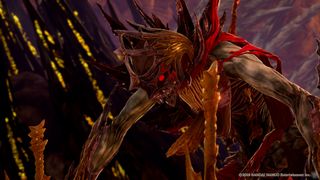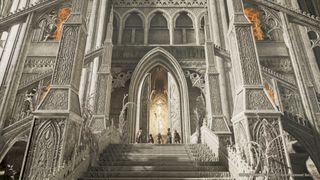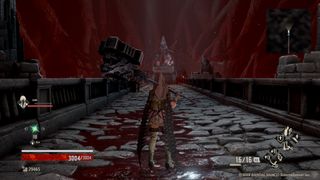Tom's Guide Verdict
Code Vein fails to come to life as a true Soulslike experience, held back by a colorless environment and lazy storytelling.
Pros
- +
Impressive build diversity
- +
Dark Souls-like difficulty
- +
Solid finale
Cons
- -
Uninspired world
- -
Poorly conceived NPCs
- -
Lazy side content
- -
Abysmal storytelling
Why you can trust Tom's Guide
Code Vein is the shameless amalgamation of two seemingly incompatible pieces of media: the "Souls-like" subgenre (Dark Souls, and the games inspired by it) and anime.
Whereas the former is striking, haunting and imbued with hidden meaning, the latter is overwhelmed with inappropriate sexualization and vapid clichés, and is often unsure of what "subtlety" means.
As a result, Code Vein is jarring, straddling a thin line between likable and unlikable.
Too much anime in my plot
Code Vein takes place in a post-apocalyptic world caged by The Red Mist: a thick fog that prevents anything from entering or leaving.

Humans, as well as two groups of beings called Revenants and the Lost, are trapped in this bubble. The Revenants, who are essentially vampires with no memory of their pasts, hunt for human blood in this dangerous hierarchy. As a thick miasma has enveloped the land, Revenants must wear masks to survive. If this miasma consumes them, the Revenants become mindless monsters, otherwise known as the Lost.
You play a Revenant who has the ability to restore memories and replenish springs of Blood Beads, which could give your species a way to drink human blood without having to hunt people down. The player's goal is to travel the world, finding Blood Beads and slowly retrieving the memories of his or her friends.
However, expecting a player to take this story seriously when a majority of the female characters are barely wearing anything is a joke. To make the situation even worse, the few articles of clothing these characters do wear are clearly pandering to a demographic of libidinous young men.
To put it gently: Code Vein's storytelling is abysmal. The acting is exaggerated and fails to convey any meaningful expressions. The shot composition is choppy, filled to the brim with poorly conceived jump cuts. And the script is staggeringly sappy, rushing immediately to emotional moments without a sliver of buildup.
Like a Souls-like
As far as gameplay goes, Code Vein follows the format of most Souls-likes.
Mistles act like bonfires: They restore your HP, respawn all enemies in the area and allow you to fast-travel. When you die, you drop all of your Haze: Code Vein's equivalent of souls, or experience points. You can upgrade your weapons through ores you find in the world, and you can also collect special items that give your gear unique attributes.

Dodging, blocking and careful timing is incredibly important in Code Vein. Enemies can seriously mess you up, so there's an emphasis on being as cautious as possible. Unfortunately, combat feels a bit unsatisfying. Smashing the Lost with a giant hammer should've felt good, but Code Vein's underwhelming attack animations and uninspired sound design fails to bring this experience to life. Regardless of what your build is, weapons don't feel properly weighted. Furthermore, the weapon types lack diversity.
However, armor is handled differently here than in most Souls-like games. Instead of separate pieces of equipment, you get a single piece of clothing called a Blood Veil. It's essentially like a cloak. It can raise your physical and elemental defenses, but it also determines how strong your Drain Attack is.
The Drain Attack is neat, as it allows the player to temporarily raise his or her max Ichor. In turn, Ichor determines how a player can use his or her special abilities, or Gifts. Additionally, backstabbing counts as a Drain Attack, and is, without a doubt, the strongest move in the game. Taking an enemy from behind increases your temporary max Ichor, does a ton of damage, and locks you in an animation in which enemies around you can't land any hits.
This adds a layer of strategy to every run, as resting at a Mistle will cause your max Ichor to return to normal. Sometimes, it’s a good idea to stock up on some additional Ichor before a boss fight so that you can use Gifts more frequently.
Impressive build diversity
The player is free to switch among classes, otherwise known as Blood Codes, whenever he or she wants. Each class has a tree of passive and active skills, ranging from fireballs to damage buffs to elemental shields. If the player has an ability on his or her action bar, killing enemies will cause a mastery meter to slowly fill up. Once the meter is full, you can pair these skills with any class.

This allows for an amazing amount of diversity when building your character, especially since there are more than two dozen Blood Codes. You can unlock Gifts by spending Haze to learn them, but there are some Gifts that you can't buy right away. You can purchase certain Gifts only after finding Vestiges, which allow the player to restore the memories of his or her party members.
What's annoying about this system is that when you find these items, restore a memory and sit through the resulting cutscene, you don't learn the ability automatically. Instead, this process merely lets you purchase the ability.
I played a Berserker/Atlas class and sported a giant hammer for a majority of the game. My build consisted of three passive abilities that raised my Strength stat to an S+ ranking, a Dragon Lunge that let my character stylishly slide into battle with a powerful jump attack, and a handful of elemental and physical resistance buffs that would keep me as durable as possible.
The beauty of this system is that if you get tired of your current build, swapping is easy. You can even switch classes mid-combat. When I was exhausted of the Berserker, I switched over to the Isis Blood Code. This class focuses on combat spells, including ones that launch giant spikes, create lightning strikes and shoot plasma orbs that lock onto enemies.
Around an NPC
While difficulty is important to the Souls-like genre, Code Vein makes a serious misstep here.

In the early stages, you're forced to patrol with a non-player character (NPC). But once you get through the first area, you can choose to go alone. Exploring without a companion is a good challenge, but fighting bosses with no backup is an absolute nightmare. Every boss is meant to be fought with a second player, which can be with an NPC alone, or with the addition of a friend via online play. The difficulty does not scale down to the player if he or she is alone.
For the first 30 hours or so, this was incredibly annoying. Tackling bosses with a companion is a breeze, but going at them alone is way too hard. My stubbornness got the better of me for my first 10 or so hours, as I absolutely refused to play with the NPC. In the end, I managed to beat only one boss by myself, after hours and hours of retrying.
However, once you're around the 30-hour mark, things change. Bosses become extremely challenging, even with an NPC. It's hard to imagine defeating one by yourself. Most bosses are an easy kill after one or two tries with a companion, but there was one boss fight that pounded me into the dirt for 2 straight hours. If Code Vein wanted to build itself around a party system, these difficult fights should have been present throughout the game. The fact that only three or four bosses are actually challenging with an NPC companion feels disappointing.
Uninspired design
Code Vein's environments are colorless, missing details that would make similar titles so striking. There are some areas that look way nicer than others, however.

The prime offenders are the Ruined City Underground and Ashen Cavern, which resort to using only one color each. Ruined City Underground is purple, and Ashen Cavern is a dull gray. It’s all homogenized, and when you spend enough time in any of these places, you'll want to leave.
Even in one of my favorite locations, the Cathedral of Sacred Blood, everything is white. While the overwhelming brightness of the design is unique for gothic architecture, it's still a good example of Code Vein's limited color palette.
Additionally, these areas are too similar: There's a destroyed city, a destroyed city on fire, a destroyed city in the sand, a destroyed city in a swamp, a destroyed city with a lot of fog and a destroyed city in a government facility. There are also three caves and two cathedrals. When you consider that Code Vein constantly reuses assets throughout these areas, it gets exhausting.
What makes this even more insulting is that areas rarely have new enemy types. Even in the final location, creatures you fought in the very beginning of the game are still present. The lack of new and monstrous foes gets old quick.
Lazy side content
While exploring the world of Code Vein, you'll occasionally pick up maps. These allow you to explore different areas in The Depths, which are dungeons. However, this content is incredibly lacking. These dungeons throw the same enemies at you, have similar environment designs and reuse bosses.
In my first two dungeons, I was dumbfounded by how both had me repeat the first boss of the game. There is practically no original content in The Depths.
Finale
Thankfully, Code Vein picks up exponentially in the finale.

Even with an NPC, boss fights get tough, requiring you to work with specific abilities to handle them. For example: Having the skill that provides resistance to blood damage will save your life. Additionally, the final area is a bizarre maze of weird shortcuts and paths that reflect what makes Souls-like games so intricate.
These moments saved the game, and the last boss is especially striking, with his blood-red arena and challenging moveset.
Bottom line
Code Vein is occasionally charming, thanks to ridiculous build diversity, moments of true difficulty and a finale that leaves a good impression.
However, the game seriously staggers due to a poorly conceived NPC system, over-the-top sexualization, effortless side content and a lifeless world with little inspiration.
Code Vein isn't worth it.

